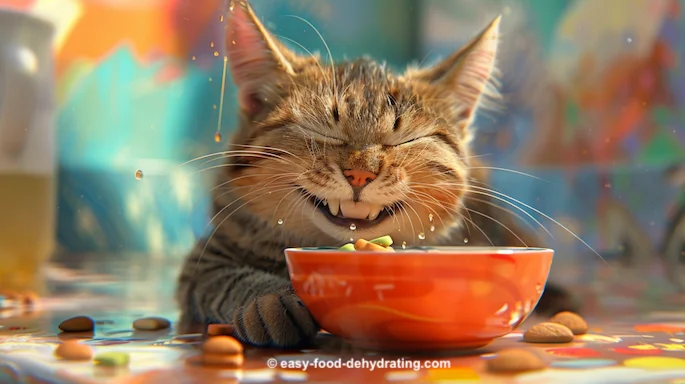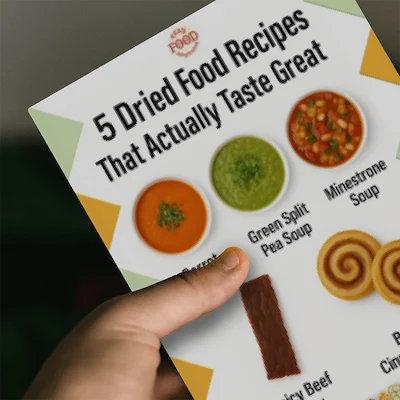What We Mean by “Dehydrate”
Here at Easy Food Dehydrating, “dehydrate” always means using an electric food dehydrator — the easy, reliable way to dry food at home.
- Home
- Homemade Pet Treats: Easy Dog & Cat Snack Ideas
- How to Make Cat Treats
How to Make Cat Treats That Even Fussy Felines Adore

If you’ve ever wondered how to make cat treats at home, you’re in the right place. With just a few simple ingredients - like cooked meats, fruits, or veggies - you can whip up tasty, dehydrated snacks your cat will adore.
✅ Quick Answer: How Do You Make Tasty Cat Treats at Home?
Use simple ingredients like cooked meats, fruits, or veggies. Slice thin, dry at 140°F in a dehydrator or oven, and store in an airtight container. Always avoid onions, garlic, and spices - and tailor treats to your cat’s preferences.
Whether you’re using a dehydrator or your regular oven, this guide walks you through the steps to keep things safe, simple, and kitty-approved.
 Jimmy - enjoying homemade treats!
Jimmy - enjoying homemade treats!Jimmy, our handsome tabby above, is thoroughly enjoying his bowl of treats.
But the real inspiration behind this page is Gracie (shown below), who is my picky little food critic and always on the hunt for something new and exciting to nibble on.
 Hi, I'm Gracie!
Hi, I'm Gracie!Whether your cat is as treat-loving as Jimmy or as selective as Gracie, you’ll find plenty of ideas here to delight your furry friend.
Let’s get started on making something special! 🐾


How to Make Cat Treats: A Simple Step-by-Step Guide
Making cat treats at home isn’t complicated — and it’s a fun way to give your feline a little something special. If your kitty’s a picky eater (like mine), it can also be a great way to sneak in foods they’ll really enjoy.
Here’s how I do it:
Choose Your Ingredients
Pick a few cat-safe favorites your furball already loves. Some good options include:
- Cooked chicken, turkey, or beef
- Plain pumpkin, sweet potato, or carrot
- A few pieces of fruit such as blueberries, banana, or apple (just a little - cats don’t need much sugar!)
Skip anything spicy, salty, or sweetened. No onions, garlic, or added flavorings - those can be harmful to cats.
Prep the Ingredients
Chop everything into small, evenly sized pieces so they dry at the same rate. You’re aiming for bite-sized treats - think “small enough for a curious paw to bat around, but big enough to chew.”
If you're using soft items like banana or pumpkin, you can mash them and shape into tiny treat blobs before drying.
Dry the Treats: Dehydrate or Bake
In a Dehydrator:
Set to 135°F–145°F. Dry for 4 to 10 hours, depending on the thickness and type of food.
In an Oven:
Set to the lowest temp (150–170°F). Prop the door open slightly to let moisture escape. Flip treats every hour and monitor closely - they may take longer than in a dehydrator.
Check for Doneness
Treats should be fully dry, brittle, and slightly crunchy. Moisture left inside can cause spoilage.
Cool and Store Properly
Once cool, store treats in an airtight container (like a Mason jar) in a cool, dry spot. They’ll keep for up to 2 months - if your kitty doesn’t gobble them all up first!

Why Make Homemade Cat Treats?
When you make your own cat treats, you get full control over what goes in - and more importantly - what doesn’t. No mystery additives, no artificial stuff.
I like to start with cooked meats like chicken, turkey, beef, or even a little salmon. You can also mix things up with a bit of hard-boiled egg or a tiny cube of low-fat cheese (some cats handle dairy fine, but go easy with it).
Want to sneak in some fruits or veggies? As mentioned, a few banana slices, blueberries, or a dab of pumpkin are ideal. Even cooked oats or rice work - just keep portions small. And don’t forget herbs like catnip or cat grass. My cats go wild for both.
⚠️ Skip the no-no’s: onions, garlic, grapes, raisins, chocolate, and nuts are all off-limits. And always cut the treats small, dry them fully, and store them in an airtight container. They’ll keep for about 2 months.
Cat-Friendly Grains & Herbs
- Herbs: Catnip, cat grass*. Dehydrate fresh leaves. See our free "How to Grow & Dehydrate Herbs" eBook here.
*CAT GRASS... It's a healthy treat for felines that is made with of any of these grasses:
- wheatgrass
- barley grass
- oat grass
- rye grass
Wheatgrass is the most popular. You can grow them at home in small pots and what's good about this is that while most houseplants are toxic to cats, these four specific cat grasses are NON-toxic.
Keep the cat grass watered and in a sunny spot (just like cats love to lie in sunny spots!) and the plants last a couple of weeks.
Can Cats Eat Fruit? A Quick Guide 🐾
Now that we’ve covered safe proteins, let’s explore more fruits that can add variety to your cat’s diet.
Fruits that are safe for cats:
- Apples - A great source of Vitamins A & C. Remove core and seeds first.
- Bananas - Excellent source of Potassium and Magnesium. Just a few bites for a treat.
- Blueberries - Loaded with antioxidants. Only feed 1-2 berries at a time.
- Cantaloupe - Good source of Vitamins A & C. Feed just a spoonful as a treat.
- Cranberries - Provides Vitamin C. Dried or fresh. Just a teaspoon or two.
- Mango - High in Vitamin C and fiber. A few chunks are safe.
- Pineapple - Contains bromelain, an enzyme that aids digestion. Only a few small bites of flesh.
- Pumpkin - Nutritious and boosts fiber. Pureed pumpkin only, not whole or in pieces.
- Watermelon- High in water & great for hydration. An occasional small wedge is fine.
ALL of the above fruits are listed on our How to Dehydrate Fruits page.
Foods to Avoid in Cat Treats
Avoid fruits high in citric acid like oranges, lemons, limes, and grapefruit, as it may cause gastrointestinal upset.
Only feed fruits sparingly, as too much natural sugar can cause diarrhea. Introduce new fruits slowly and monitor your cat’s reaction.
Always remove rinds, skins, pits, and seeds first, as those parts can be toxic to cats.
Tips for Introducing Picky Eaters to New Treats
Got a fussy feline? Here are some easy, low-stress ways to help your cat warm up to homemade treats:
- Start Small: Offer just a tiny piece alongside their regular meal. If they sniff it and walk off, don’t panic - cats love to pretend they’re uninterested.
- Mix It In: Crumble the treat into their usual food. Blending familiar and new flavors can make it more inviting.
- Soften It Up: Rehydrate a piece in warm water or low-sodium broth. Some cats prefer a softer, wet-food texture at first.
- Pair with a Favorite: Put the new treat next to something they already love - like a dab of tuna or their go-to snack.
- Use Praise (Not Pressure): If they show interest, give them a little praise or affection. If not, no guilt trips - forcing it might backfire.
- Try Different Flavors: Some cats are salmon snobs, others live for chicken. Experiment and see what gets the whiskers twitching.
- Serve Fresh: Keep treats in an airtight container. Stale snacks? Total turn-off.
- Be Patient: Cats are creatures of habit. It might take a few tries before they decide this “new thing” is actually worth eating.
- Watch and Learn: Pay attention to their reaction. If it’s a hard no every time, tweak the recipe or try another combo.
"If we measured our affection toward others
by how many nicknames we bestow upon them,
our pets would be the most loved."
— Carrie Brownstein
"If we measured our affection
toward others by how many
nicknames we bestow upon
them, our pets would
be the most loved."
— Carrie Brownstein
FAQ: Common Questions About Homemade Cat Treats
How long does it take to dehydrate cat treats?
How long does it take to dehydrate cat treats?
It depends on what you’re drying and how thick you slice it. In general:
- Meat or fish: About 4 to 6 hours at 145°F
- Fruits and veggies: Closer to 6 to 10 hours at 135°F
Always make sure the treats are fully dry - they should feel firm and a bit brittle, not bendy or sticky. And yep, check your dehydrator’s manual if you’re unsure — they can vary a bit.
Can I use an oven instead of a dehydrator?
Can I use an oven instead of a dehydrator?
Sure can! Just set your oven to its lowest temperature (usually around 150°F–170°F) and prop the door open slightly so moisture can escape. It takes a little longer this way, and you’ll want to flip the treats now and then - but it works just fine in a pinch.
What ingredients should I avoid when making cat treats?
What ingredients should I avoid when making cat treats?
Some ingredients are a hard no for cats. Steer clear of:
- Onions or garlic (even powdered)
- Grapes or raisins
- Chocolate (of course!)
- Macadamia nuts
- Citrus fruits
- Raw dough or raw meat
These can make your cat really sick, even in small amounts. I always say - if you’re unsure, skip it or run it by your vet.
What if my cat snubs the treat?
What if my cat snubs the treat?
Welcome to the club! 😹 Some cats are drama queens when it comes to food. If they turn up their nose, try a different ingredient, soften the treat with warm water, or mix it with something they already like.
And hey - if all else fails, your dog might think it's the best thing ever.
Can dogs eat these treats too?
Can dogs eat these treats too?
Most of the time, yes - especially if you're using plain meats or veggies. Just avoid any ingredients that are harmful to either cats or dogs (like onions, garlic, grapes, or chocolate). And of course, keep portion sizes small - even if your pup thinks he's earned the whole batch.
→ A happy pet starts with a safe home - see these smart decor tips for pet-friendly kitchens Check out these pet-hazard tips.
Whether you’re making treats for your furry friend or dehydrating snacks for yourself, the method is the same - dry it right and store it smart.
If you’re new to food dehydrating, I’ve put together a handy free PDF (below) with 5 Dried Food Recipes you can try next. They’re quick, tasty, and great for practicing your skills.👇
Get 5 Dried Food Recipes You'll Actually Love
Here's where you can get your copy of our all new
5 Dried Food Recipes (That Actually Taste Great)
They're my all-time favorite easy dried food meals!
Get it here right now.
For Free!
Before You Go...
If you enjoyed this page, tap the ❤️ in the lower right-hand corner.
It saves this page to your Grow bookmarks so you can find it again later.
You’ll also see quick share buttons to copy the link, post to Facebook,
or save it straight to Pinterest.














